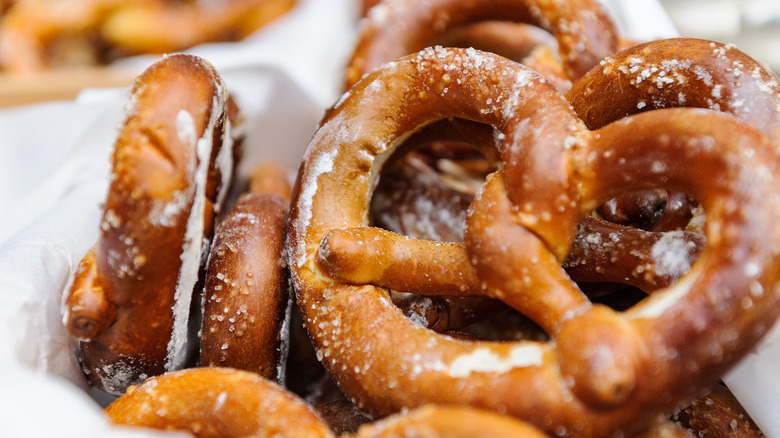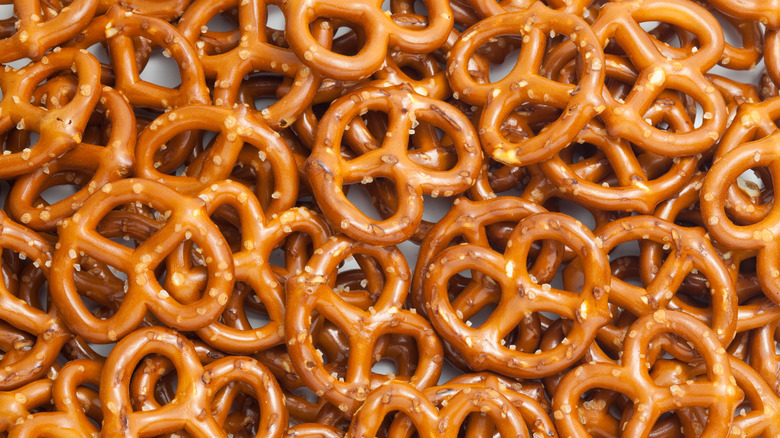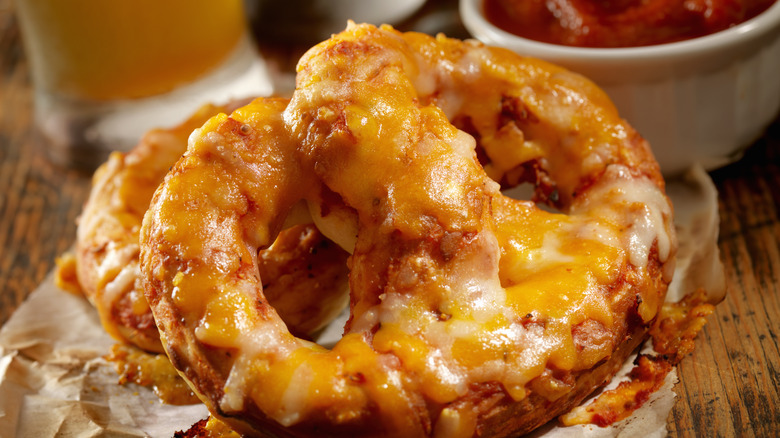The Twisted Origin Behind The Pretzel's Iconic Shape
Although we commonly associate pretzels with Germany, this snack might actually have roots in Italy, going back as far as 610 A.D. One popular legend suggests that a monk created the pretzel to represent arms crossed over one's chest in prayer. Others say that pretzels evolved from early Catholics needing simple foods for sustenance during Lent, with the three holes in the pretzel representing the three parts of the Holy Trinity. Regardless, the snack's twisty shape would later come to be associated with knots and good fortune, making pretzels a welcome appetizer at wedding parties and a common symbol in coats of arms.
Like the pretzel's exact origins, scholars have posited multiple theories as to how its name came to be. According to the legend of the monk, homemade soft pretzels were dubbed "pretiola," or "little rewards," to be handed out to his students for good behavior. Other theories say that pretzels were originally nicknamed "bracellae," or "little arms," in reference to the crossed arms imagery. The Germans later translated this to "bretzel," further shedding light on the etymology of the word "pretzel."
Germans likely brought pretzels to the United States
Although pretzels had spread across much of Europe by the 17th century, many people credit the Germans with bringing them to what would later become the United States. As early as 1683, German settlers fled to Pennsylvania to avoid religious persecution, though some scholars say pretzels themselves didn't arrive until a few decades later.
No matter the exact timeline of pretzels' arrival, Julius Sturgis opened one of the first commercial pretzel bakeries in 1961, located in the Pennsylvanian town of Lititz. Further legends suggest that Sturgis' hard pretzels came about as a mistake when he baked soft pretzels too long, though others say the creation was intentional.
After all, while soft pretzels are only good for a few days, hard pretzels stay fresh for several weeks, meaning they could be packaged and transported before being sold elsewhere. Of course, today we know how to revive stale snacks, so pretzels can be enjoyed even longer.
Modern pretzels are diverse in every way
Today, Pennsylvania continues to dominate the pretzel industry, producing about 80% of the nation's supply, but pretzels now come in countless varieties. In addition to the classic twist, hard pretzels can be made in sticks, rods, waffles, bites, braids, circles, crisps, and many other shapes. They might be dusted in cheese or mustard, filled with peanut butter, sprinkled with everything bagel seasoning, or coated in chocolate. You can even find butter or sourdough kefir pretzel recipes alongside traditional takes.
The variations only continue when you look at soft pretzels. These can again be stuffed or dusted — a cinnamon sugar pretzel? Yes, please! Some soft pretzels have even been turned into tiny pizza bites, baked with globs of cheese and pepperoni. Others are transformed into garlic bread with cheese and garlic butter. Still others are used as sandwich or burger buns. Truly, pretzels have found their way into both sweet and savory categories, available at amusement parks, stadiums, and restaurants. It's amazing how such a simple treat can spark so much joy across the world.



